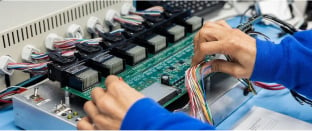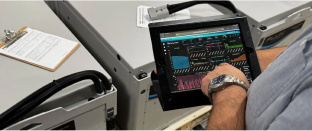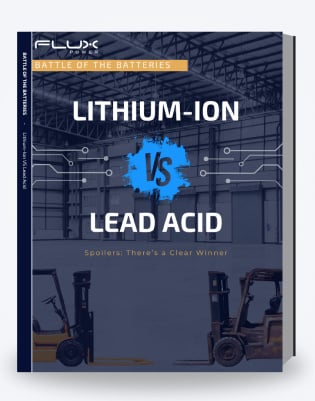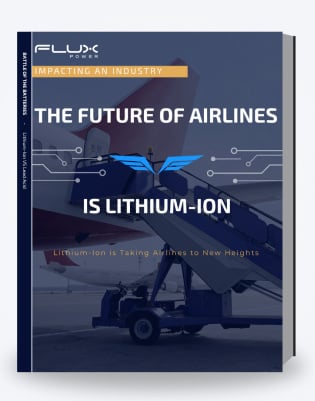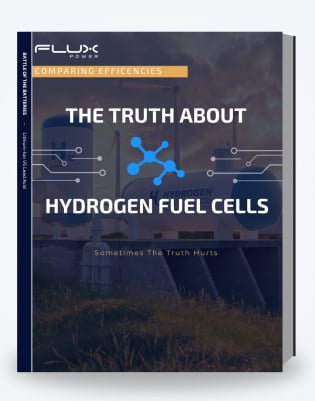For years, lead acid batteries have been the “go to” source of power for electronics, vehicles and equipment. However, thanks to several features that promote efficiency and safety, lithium-ion batteries are becoming a popular choice across several industries.
One of the most important characteristics for a company that uses batteries in its forklift fleet is the life of the battery. How long the battery lasts while in use plays a critical role in a company’s operations. When it comes to a business’s bottom line, efficiency matters.
When weighing whether lithium-ion or lead acid battery life is a better fit for a fleet, here are some of the main differences between the two.
Usage Times
Between lithium-ion and lead acid batteries, there is a stark difference in the life of the battery during day-to-day operations.
Lithium-ion Batteries
Lithium-ion batteries feature a battery life that has a remarkably fast charging time. This allows multi-shift crews to use lithium-ion battery power for longer periods of time over the course of a day and charge the battery when convenient.
That’s because lithium battery packs have no memory effect, making partial charges possible. In fact, partial charges are safer and can prolong the overall life of a lithium-ion battery.
A typical charge or use cycle for a lithium-ion battery is 8 hours of use, 1 hour to charge and another 8 hours of use. No cool down period is needed. This allows the battery to be used continuously throughout a 24-hour shift, with downtime occurring only during short periods of opportunity charging. This can occur during workers’ lunch breaks or in between shift changes.
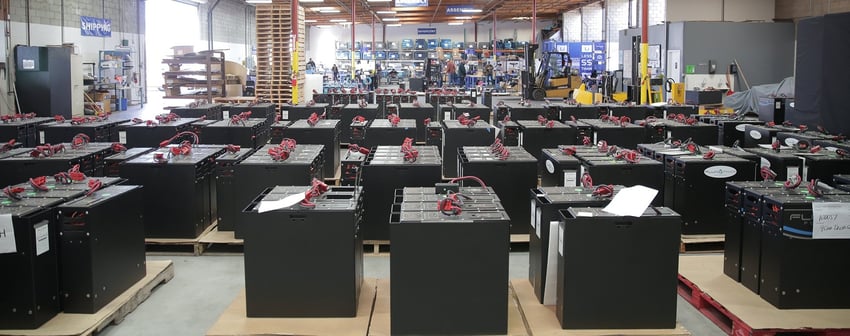
Because of the way the life of a lithium-ion battery is designed, it’s important to always keep this type of battery at least partially charged. If batteries are reduced to zero or extremely low charges, circuits put in place for protection may turn off. The circuits are put in place to protect the battery. When a battery is discharged to extremely low levels dendrites can form which can short circuit the battery.
Lead Acid Batteries
Lead acid batteries, on the other hand, produce a substantial amount of heat when charging. Because of this, they require a “cool down” period afterward.
A typical charge and use cycle for a lead acid battery is 8 hours of use, 8 hours of charging and 8 hours of rest or cool down. This means a lead acid battery can only be used for one shift per day. If a company employs workers to cover two or three shifts, lead acid batteries must be swapped out. That means per vehicle or piece of equipment, two to three batteries are needed (one per shift).
| Lead Acid | Lithium-Ion | |
| Charging Time | 8 hours | 1-2 hours |
| Cool-Down Period | 8 hours | Not Needed |
| Charging Method | Removed from forklift, placed in charging base and taken to special charging storage room | Plugged directly into the wall, even while the battery is installed in the forklift |
| Safe Discharge | Down to 30% - 50% capacity | Down to 20% capacity |
| Opportunity Charge | No | Yes |
Lead acid batteries also require a storage area with adequate ventilation so that dangerous gases do not seep into other work areas while they charge and cool down. Transporting the batteries to these locations takes additional time out of a worker’s shift.
Lifespan
Large battery packs used in industries like warehouse operations and airport ground support equipment are an investment, no matter the type. So, operations benefit from batteries that can be used in a fleet as long as practical.
Lithium-ion Batteries
Lithium-ion batteries have a long life expectancy if used correctly. This is a distinct advantage for operations that rely on efficiency and high production levels.
Contributing to longer lithium-ion life cycles includes:
- Higher power density level
- Slower rate of capacity loss
In fact, the overall life of these rechargeable batteries in pallet jacks is 2 to 3 times longer than lead acid batteries. Run time testing has shown that the Lithium-Iron Phosphate batteries used in a Flux LiFT Pack for an electric walkie pallet jack run 45% longer than similarly rated (amp-hour) lead acid batteries. 
The minimum lifespan most manufacturers expect from lithium-ion batteries is around 5 years or at least 2,000 charging cycles. But, if well cared for and used in proper conditions, lithium-ion batteries can last as long as 3,000 cycles.
Lead Acid Batteries
lead acid batteries, as well, have a similar life span in terms of cycles. Many manufacturers point to a similar figure of at least 1,000 charging cycles if used in proper conditions. However, extreme heat and other environmental factors can significantly reduce the life of a lead acid battery.
In addition, the increased maintenance requirements for lead acid batteries can also lead to shorter lifespans. It is not uncommon for personnel to have poor maintenance tracking procedures or not care for lead acid batteries in the manner recommended by the lead acid battery manufacturer.
Influences
In both lithium-ion and lead acid batteries, there are several factors that can influence the life of the battery.
Lithium-ion Batteries
Here are some of the factors that influence battery life:
- Extreme temperatures: Lithium-ion batteries are extremely resilient to high and low temperatures. Lithium iron phosphate, the chemistry used by Flux Power, is especially resilient. We even offer heaters for batteries that will be used in cold temperatures to ensure a longer lifetime for the battery.
- Improper storage: How a battery is stored can affect its lifespan. Lithium-ion batteries should be stored at a partial charge in a cool place. They should have around a 40% to 50% state of charge when being stored. If being stored for extended periods of time it is important to monitor the battery every couple of months and charge it back up to 50% if it gets too low.
- Deep cycling: The life of a lithium-ion battery can be impacted by deep cycling. Unlike other deep cycle batteries, partial charges prolong the life of a lithium battery.
For more factors that influence the life of a lithium-ion battery, read our article, How To Maximize Lithium-Ion Battery Life.
Lead Acid Batteries
Environmental factors and how lead acid batteries are used also play a significant role in battery life. These factors include:
- Extreme temperatures: Like lithium-ion batteries, the lifespan of a lead acid battery can be shortened when exposed to extreme temperatures, especially heat. After charging, lead acid batteries require a cooldown period because the act of charging produces high amounts of heat.
- Water levels: Overfilling water levels in a lead acid battery can cause electrolyte loss, reducing the lifespan of a battery. This can also promote corrosion of the battery, which can cause batteries to unevenly charge, which reduces lifespan.
- Deep discharge: The life of a lead acid battery suffers when a deep discharge occurs, and the battery is left “dead” for an extended amount of time.
Bottom Line
Purchasing batteries for a fleet is a significant investment. The life of each battery directly impacts the efficiency of a company’s operations and its workers.
One of the greatest advantages a lithium-ion battery provides is its long lifespan and extended battery life during day-to-day operations. With a short downtime for charging, lithium-ion batteries are especially beneficial in multi-shift locations, such as in warehouse operations.
One battery can provide a source of power for three shifts. A lead acid battery, on the other hand, can only provide power for one shift of eight hours before it requires a charging and cooldown period. This requires one battery per shift for each vehicle, which cost companies significantly more in the long term.
FAQs - Lithium-ion Batteries & Lead-Acid Batteries
Q: How does the lifespan of lithium-ion batteries compare to lead-acid batteries?
A. Lithium-ion batteries typically last between 2,000 and 3,000 cycles, while lead-acid batteries average 1,000 to 1,500 cycles—offering roughly double the lifespan.
Q: What are the differences in charging times between lithium-ion and lead-acid batteries?
A. Lithium-ion batteries can be fully charged in 1 to 2 hours and support opportunity charging. Lead-acid batteries require about 8 hours to charge plus an additional cooldown period.
Q: How does maintenance differ between lithium-ion and lead-acid batteries?
A. Lithium-ion batteries are virtually maintenance-free, requiring no watering or equalizing. Lead-acid batteries, as discussed in this post on common maintenance issues, need regular attention to avoid performance issues.
Q: Can lithium-ion batteries be opportunity-charged without affecting their lifespan?
A. Yes, lithium-ion batteries can be charged during breaks or shift changes without negatively impacting lifespan. Lead-acid batteries, by contrast, degrade faster if not charged completely.
Q: What safety advantages do lithium-ion batteries have over lead-acid batteries?
A. Lithium-ion technology eliminates hazards like acid spills and gas emissions. Lead-acid batteries pose greater safety risks during charging and handling.
Q: How do Flux Power's lithium-ion batteries enhance operational efficiency?
A. Flux Power's batteries reduce downtime through faster charging and lower maintenance needs, which can significantly improve ROI—especially when compared to the hidden costs of lead-acid systems.

